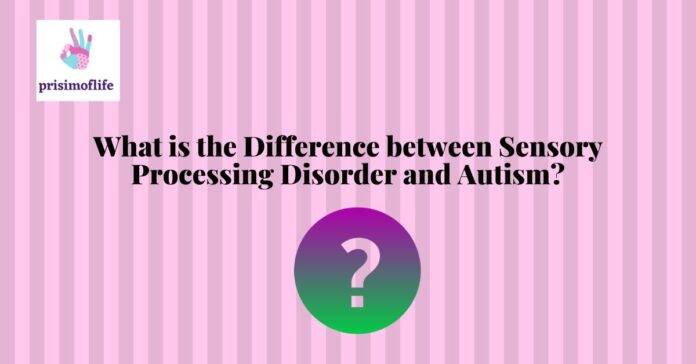What is the Difference between Sensory Processing Disorder and Autism? This question often creates confusion for those who seek an ultimate difference between the two. Many people confuse sensory processing disorder and autism, especially since some children with autism also have sensory processing issues.
The truth is that they are two separate conditions that have very little in common and respond to very different types of treatment. This guide will help you understand the difference between sensory processing disorder and autism so you can seek out the proper treatment for your child. Sensory processing disorder (SPD) and autism share some similarities, but the former differs significantly from the latter.
That’s why it’s essential to understand their differences and how they might impact your child. Here’s what you need to know about sensory processing disorder vs autism—and how to know if your child has SPD or autism.
The Basics
There are many misconceptions about what sensory processing disorder (SPD) actually is. Many people think it’s just a made-up diagnosis that gives parents an easy out to explain why their child has a hard time coping in certain situations. In contrast, others believe it’s related to autism spectrum disorder (ASD). In reality, SPD is not really a diagnosis at all; instead, it’s a set of symptoms that can be associated with different developmental disorders.

Similarities between SPD and Autism
Both SPD and autism are diagnosed when individual struggles to interact with their environment. In these cases, it’s important to be aware of similar sensory issues that can occur in both conditions. For example, people with autism may have a heightened sensitivity to loud noises and bright lights.
People with SPD may also have sensory sensitivities but not enough to interfere with daily life. Instead, their symptoms are only apparent during times of heightened stress or emotional arousal. As a result, parents sometimes don’t connect their child’s behavioral problems to sensory issues for quite some time.
Differences between SPD and Autism
The Importance of Getting an Accurate Diagnosis If your child is diagnosed with sensory processing disorder (SPD), you might wonder if it’s possible for them to have autism spectrum disorder (ASD). That’s a reasonable concern, given that SPD and ASD are two different diagnoses.
After all, both SPD and ASD could be classified as developmental disorders, but only one – autism – has autism in its name. If your child has been diagnosed with SPD or ASD, here are some important differences between these conditions
Is Sensory Processing Disorder a Subset of Autistic Spectrum Disorders?
According to Susan N. Yonan, MS, OTR/L, and author of The Out-of-Sync Child, an essential aspect of sensory processing disorder (SPD) is its mislabeling as an autism spectrum disorder (ASD). Yonan explains that the only thing SPD has in common with autism spectrum disorders (ASDs) is neurological disorders. Otherwise, they are very different disorders.
Those who have been diagnosed with SPD did not present with any language delay or cognitive impairment. While people with ASD typically experience a social deficit early on in life, those with SPD generally do not experience these same deficits until adolescence.
Are Autistic Children Less Likely to Develop Sensory Integration Disorders than Neurotypical Children are?
Some studies have shown that neurotypical children are more likely to develop sensory integration disorders than autistic children. However, these studies were primarily performed before doctors began recognizing autism at younger ages. So it’s possible that autistic children today may be diagnosed at earlier ages and are more likely to be identified as having a sensory processing disorder.
One study has shown that autistic children who exhibited high levels of maladaptive behaviors had higher rates of sensory issues than those who did not exhibit such behaviors. Therefore, it may be very important for parents and doctors to keep an eye out for signs of maladaptive behavior in their autistic patients so they can act accordingly.
Treatment Options
One significant difference between autism and SPD involves treatment. While there is no cure for autism, parents of children with SPD can work with professionals to help their kids make sense of stimuli through various behavioral techniques, including sensory-based occupational therapy. Occupational therapists can also teach these children relaxation skills to help them cope more effectively with overstimulation in future settings.
Some common tools include weighted blankets, white noise machines, and special weighted or texture-based toys. While these tools might not fully cure someone from having sensory processing disorder, they can make life much easier for kids who struggle every day when trying to handle too much stimulus at once.
Conclusion
Sensory processing disorder is a neurological condition that causes you to perceive things differently than other people. For example, someone with SPD may over-sensitize to certain sensations or under-sensitize to different sensations. You may also have problems regulating your behavior due to these sensory differences. (Autism Society) In contrast, autism doesn’t have anything specifically to do with sensory perception; it’s a developmental disorder that affects brain development early in life. ASD has nothing directly related to your senses but more related to how you interact socially, use language, and show empathy towards others. Learn more about autism here if you haven’t already done so.










